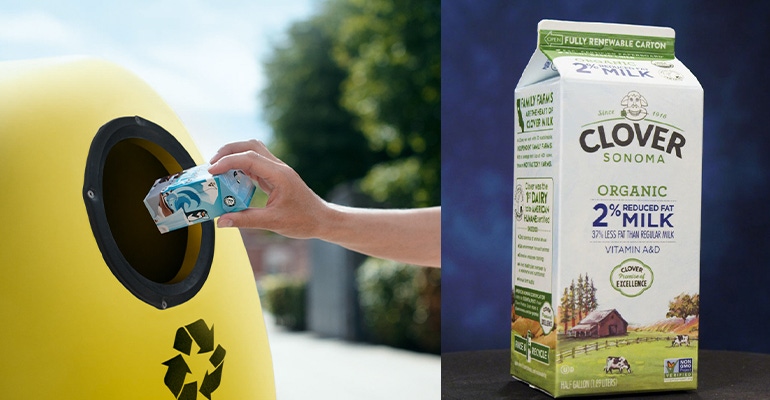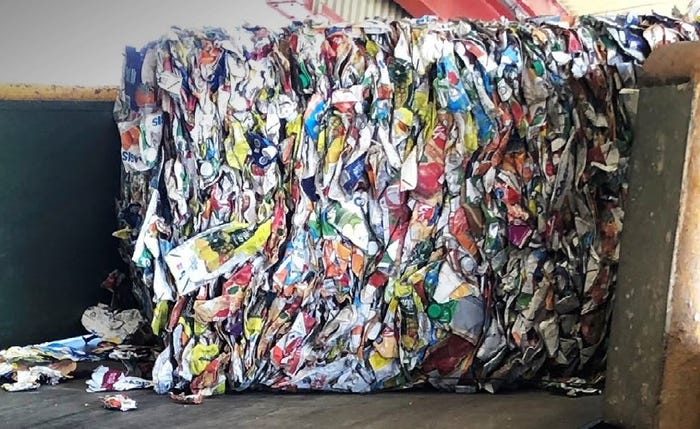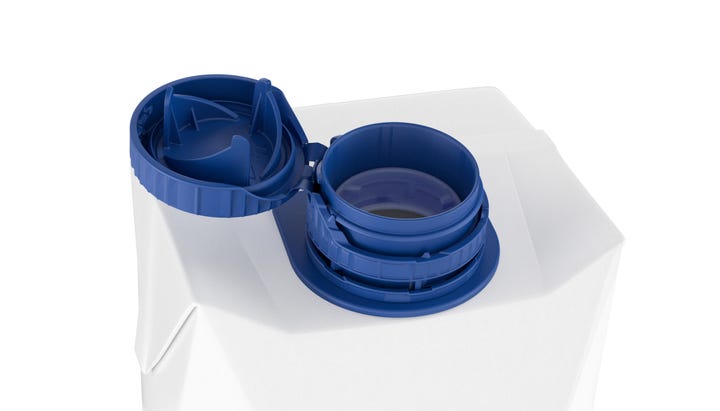8 Sustainable Improvements in Food and Beverage Cartons
Tetra Pak’s 2021 Sustainability Report discloses news surrounding plant-based packaging, tethered caps, aseptic carton recycling, and food-waste-saving advances.
August 26, 2021

Aseptic packaging pioneer Tetra Pak continues to innovate cartons for shelf-stable and chilled products in shape, size, and materials. In fact, a range of news and breakthroughs are cited in the company’s recently released 2021 Sustainability Report that encompasses all aspects of the topic from both global and US/Canada perspectives. We’ve selected eight packaging highlights from the 165-page PDF document.
1. Non-foil aseptic packaging.
In 2020 Tetra Pak conducted technical validation through a limited commercial launch of the first-generation non-foil aseptic packaging solution, which replaces the aluminum barrier layer for aseptic products with a polymer film applied with a proprietary coating. It offers a similar barrier with a significant climate-impact reduction.
A Life Cycle Assessment to quantify this reduction is still pending, but it’s a certainty: the aluminum layer just 5% of the total base materials by weight but has one-third of the Greenhouse Gas (GHG) emissions. The first-generation non-foil packaging solution is now on the supermarket shelf and cuts the carbon footprint by nearly 25%.
2. 100% renewable, plant-based coatings for cartons.
The company introduced a chilled product carton made from plant-based renewable materials, selling more than one billion of these carton packages in 2020. The first Tetra Pak carton in the US or Canada to use a plant-based (sugarcane) polymer coating that reduces the carbon footprint for every package was introduced by Clover Sonoma, a small, family-owned business in Sonoma, CA. The carton graphics (shown in the feature image at top) showcase the brand’s commitment to sustainability that includes FSC-certified paperboard. Because the packaging has been “incredibly successful,” Clover Sonoma plans to convert 100% of its liquid-packaging portfolio to fully renewable packaging by 2025.
Tetra Pak's Denton, TX, plant is capable of producing cartons made with the plant-based coating for aseptic products as well.

3. Aseptic carton recycling expands.
Tetra Pak reports that the number of facilities that recycle carton packages worldwide grew from 40 in 2010 to more than 170 today. The number of Tetra Pak carton packages collected for recycling increased from 32 billion in 2010 to 49 billion in 2020, equivalent to an overall recycling rate of 27%.
The industry continues to add capacity; among the six European examples of carton recycling was a partnership with corrugated carton producer L-PAK in Russia for the launch of a new recycling line for carton packages with an annual capacity of 12,000 tons. The paperboard component is processed into corrugated cardboard and other materials, including secondary packaging for the food and beverage industry.
Note: While not in the report, I learned that left side of the featured image at the top shows recycling stateside, where cartons must remain unflattened due to how US sorting machinery operates; elsewhere cartons are flattened for recycling.

4. Tethered cap.
The company accelerated R&D for a tethered cap to comply with new EU legislation to become law in July 2024. Tetra Pak’s first tethered cap set for release is the HeliCap 26 Pro closure, which features a new screw-and-flip concept with a self-locking hinge.
The caps will also be made available as a plant-based option to increase the renewable content of the package while minimizing litter.
5. Recycled content bundling film.
Tetra Pak has deployed across Europe a protective, recyclable secondary packaging film made of 50% post-consumer recycled plastic.
6. Food-waste-reducing digitalization.
The company is leveraging the benefits of digital technologies in customer machinery and on packaging. The latter centers on Quick Response (QR) codes that can help extend the shelf-life of products and reduce food waste. As well, it can follow products through distribution and, if packages are damaged, identify why this is happening and take corrective steps.
The code’s offers real-time stock levels and shelf-life information for retailers and enables dynamic pricing whereby products nearing the end of their shelf-life can be discounted to ensure a quick sale. The codes enable consumers to trace the origin of the product they are buying and verify “use before” and “best within” dates.
7. Diverting food waste.
One of two feel-good examples of food waste reduction cited was from the US where food upcycler Matriark Foods uses vegetable farm surplus and fresh-cut remnants that would otherwise be wasted and sent to landfill. These ingredients are processed into healthy, low-sodium vegetable products for use by schools, hospitals, food banks and other food service channels. The product was launched in March 2020.
8. Energy-saving eBeam sterilization.
Sustainable advancements continue on the carton packaging machinery side, too. Tetra Pak reports that a collaboration with then-partner COMET led to electron beam (eBeam) sterilization to replace traditional hydrogen peroxide for packaging materials that offers the same efficacy. Introduced in 2017, these systems can reduce energy consumption by as much as one-third. The newsy bit is that in 2020, Tetra Pak acquired the eBeam development and manufacturing operations from COMET, “further boosting our ability to deliver sustainable and higher efficiency filling lines.”
The PDF of the full report can be downloaded here.
You May Also Like


